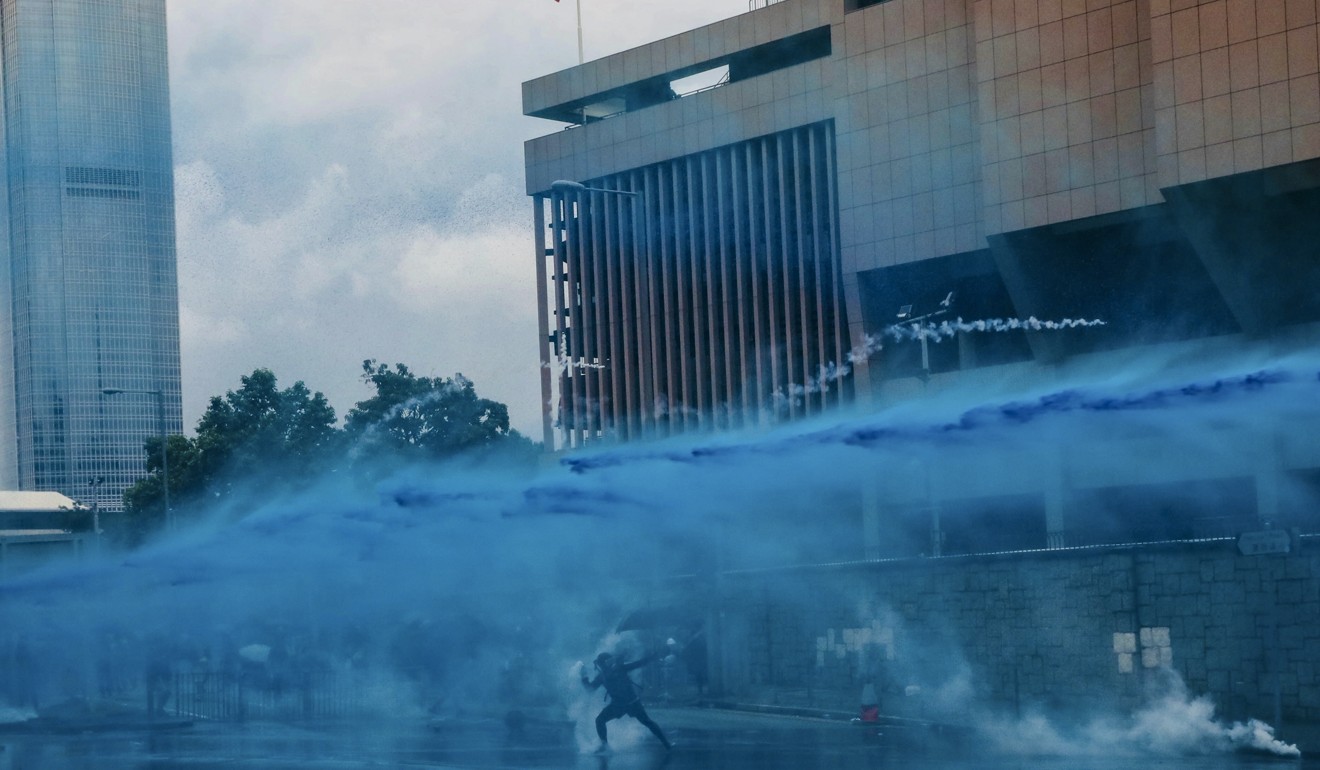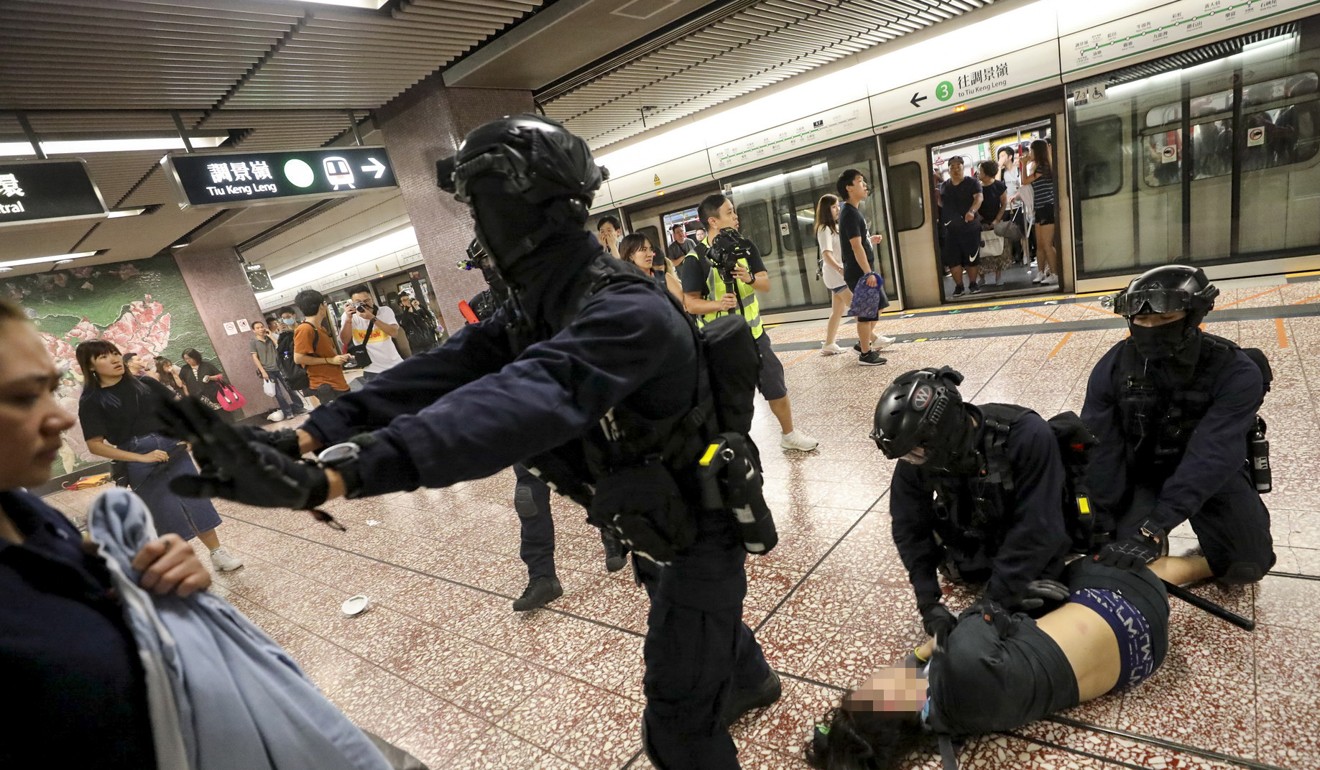
Hong Kong burns in night of violent protest with live rounds shot, multiple fires lit on streets, and MTR paralysed
- Elite ‘raptors’ from Special Tactical Squad fight pitched battles in smoke-filled streets with hard-core protesters
- Water cannons fire jets of blue dye at protesters while bricks and petrol bombs hurled at police, before late-night clashes on trains
Anti-government protesters are planning on Sunday afternoon to disrupt all travel routes to Hong Kong airport, after a day of chaos and violence as rampaging demonstrators lit fires and hurled petrol bombs at riot police well into the night.
Protesters are calling on the public to overwhelm road and rail links to the airport on Sunday and Monday to cause flights to be cancelled, in a hoped-for repeat of their actions a fortnight ago.
LIVE: Airport trains suspended as protest near aviation hub kicks off
On Saturday, police fought back, well into the early hours of Sunday, at first firing rounds of blue dye from water cannons, and then sticking to their tested means of dispersal, multiple shots of tear gas, as the city marked yet another weekend of heightened violence.
Police also fired two live rounds into the air to fight off a violent mob near Victoria Park in Causeway Bay, sources told the Post, as word spread of undercover officers mingling with the demonstrators.
Across various locations, elite “raptors” from the Special Tactical Squad fought pitched battles in smoke-filled streets with hard-core protesters, or chased after them, wrestling some to the ground as they made on-the-spot arrests.
Hard-core elements took their criminal acts to new extremes by lighting bonfires of cardboard and other flammable material, rubbish bins and any junk they could lay their hands on as they moved from one district to another leaving a trail of destruction in their wake, almost always a step ahead of police.
Defying a ban on demonstrations, they took over roads and mounted makeshift barricades from behind which they hurled bricks and petrol bombs at police lines.
Five years on from ‘831 framework’ problem of electoral reform persists
They first began by besieging police headquarters in Wan Chai, throwing petrol bombs at the heavily barricaded building.
At one point, they surrounded the equally barricaded government headquarters and the Legislative Council compound, hacking down a fence with metal poles and throwing bricks at riot police standing watch inside, as others flashed laser pointers at officers.
By night-time, the demonstrators fanned out across the harbour to Kowloon, in a flash mob-style protest in the tourist hub of Tsim Sha Tsui, setting off more fires along the main shopping artery of Nathan Road and its side streets.
Riot police again charged at them and fired rounds of tear gas. The protesters dispersed and reappeared an hour later farther north in Mong Kok, in even larger numbers.
Across many parts of the city throughout the day, the shrill sirens of fire engines pierced the air. Overhead, Super Puma helicopters dispatched by the Government Flying Service zigzagged across Admiralty, Wan Chai and Central, the roar of their rotor blades mixing with the battle cries of protesters in a soundscape of a city at war.
“This is an example of the Hong Kong government and police suppressing us,” retiree and protester Michael Chu, in his 60s, said at Chater Garden as the helicopters, which a government website said were used for “internal security and control of terrorist activities”, hovered above.

Still, that did not stop the mobs from vandalising several stations, including breaking a glass platform screen door at Wan Chai MTR station, jamming turnstiles at Admiralty and defacing walls there and at several stops, including Causeway Bay, Tin Hau and Fortress Hill.
In an early morning press conference, police said 40 people had been arrested inside Prince Edward station for “participating in an illegal assembly, destroying property and obstruction of justice”.
One clip showed officers from the squad hitting two men and two women in masks who were crying and cowering on the ground, while one officer pepper sprayed them.
Other footage showed several commuters bleeding from head wounds, and officers tying up suspects who had been wrestled to the ground.

Police said they entered the MTR station as there were protesters destroying ticketing machines and the MTR control room window, and said they had received emergency calls about a dispute in the station. Mong Kok MTR station was also vandalised.
“We disagree with the allegations police officers had entered the MTR stations to beat people up,” a police spokeswoman said.
Blue dye fired from water cannons – protesters adjust with clothes, cleaning tips
Police had banned Saturday’s demonstrations citing serious security concerns and organisers said they cancelled the event but called on people to flash their cellphones at precisely 8.31pm to mark the fifth anniversary.
But the moment came and went unnoticed as protesters and police faced off in a what has become a regular routine of cat-and-mouse at multiple locations.
Earlier in the day, defying the police ban, large crowds – many donning their trademark black T-shirts and armed with their umbrellas – made their way, at first peacefully, through various streets of Hong Kong Island, taking over roads and chanting slogans such as “Save our freedom” and “Liberate Hong Kong, revolution of our times”.

Spotted in the crowds, too, were protesters who did not put on masks, openly daring police to arrest them for marching illegally.
But soon chaos reigned as radicals swarmed around the seat of government and finance in Admiralty and Central. The mob threw rocks, started fires and shined laser pointers at police officers behind a barricade at Legco.
By 5.30pm, police patience ran thin and the anti-riot water cannons came out, firing a relatively mild spray and rounds of tear gas to disperse the crowds, who fought back by throwing yet more petrol bombs and sparking fires.
Barely an hour later, protesters armed with metal poles had found a weak link in the blue-and-white water barricades around Legco – a stretch of metal fencing – and began hacking at it.
First-time protester enters the fray – unmasked, angry and certainly not alone
The water cannons made another appearance and from a distance across the road sprayed jets of blue liquid mixed with pepper spray as riot police fired more tear gas at the protesters.
The mob dispersed in different directions and within minutes was all but gone, leaving the mounds of mangled metal fences, rubbish bins, traffic cones and other junk they had amassed.

In a scene reminiscent of the storming of the building then, when protesters used a metal cart as their battering ram to smash through Legco’s glass exteriors, a group appeared with a makeshift barricade made of a section of stadium seats.
They used this fortification to start a fire and within minutes, a large blaze was lit. Three explosions were heard as they then threw petrol bombs into the flames.
Earlier, protesters tried to go to the official residence of embattled Hong Kong leader Carrie Lam Cheng Yuet-ngor but were turned away by a phalanx of riot police.

John Cheung Kwok-keung, a 30-year-old import-export businessman, was among the protesters out and about, distributing supplies including meal coupons, masks and T-shirts.
He said he had been doing so since the demonstrations began in June, his supplies paid for by well-to-do parents of young protesters. Cheung said he was not deterred by warnings about the marches being illegal.
“I still have faith in Hong Kong’s courts and judges that I will be vindicated even if police move to arrest me,” he said.
Another protester, fully masked, said: “I don’t care. I will do my best to escape, but if it’s my fate, so be it.”
Chaos on Hong Kong’s MTR network as police chase protesters into station
Earlier in the day, protesters gathered at Southorn Playground in Wan Chai for a religious rally to “pray for sinners”, and they sang hymns before marching to Lam’s residence at Government House. The group insisted that as they were part of a religious event, they did not need police approval.
The “sinners” rally was organised after the Civil Human Rights Front cancelled a march from Central to Beijing’s liaison office in Western District after an appeals panel’s decision to uphold a police ban on the event.
They set off from the playground singing songs including “Sing Hallelujah to the Lord”.

The only relatively safe area on Hong Kong Island during the day was Western district.
Police had ordered a lockdown, to protect the liaison office, with roads closed and public transport shut down by 1pm. Trams were suspended, the MTR service to Sai Ying Pun stopped and bus routes diverted.

The liaison office – all but surrounded by two-metre high water-filled barriers, and with several police vehicles stationed nearby – stayed pristine throughout.
Last Sunday, a policeman fired a live round into the air after he and colleagues were chased and beaten by a mob wielding iron poles in Tsuen Wan. This Sunday, protesters have vowed to cause chaos at the airport in what could be yet another day of mayhem.

